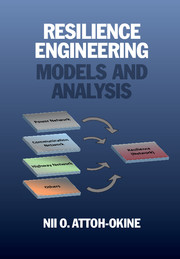Book contents
- Frontmatter
- Contents
- Preface
- Acknowledgments
- PART I INTRODUCTION
- PART II INFRASTRUCTURE SYSTEMS
- 2 Infrastructure Systems
- 3 Disruptions
- 4 Graphs and Networks
- 5 Big Data and Resilience Engineering
- 6 Graphical Models
- 7 Belief Functions
- 8 Tensors Applications
- 9 Resilience Index—Selected Examples
- 10 Epilogue
- Index
- References
4 - Graphs and Networks
from PART II - INFRASTRUCTURE SYSTEMS
Published online by Cambridge University Press: 05 March 2016
- Frontmatter
- Contents
- Preface
- Acknowledgments
- PART I INTRODUCTION
- PART II INFRASTRUCTURE SYSTEMS
- 2 Infrastructure Systems
- 3 Disruptions
- 4 Graphs and Networks
- 5 Big Data and Resilience Engineering
- 6 Graphical Models
- 7 Belief Functions
- 8 Tensors Applications
- 9 Resilience Index—Selected Examples
- 10 Epilogue
- Index
- References
Summary
Introduction
The fundamental concept of graph theory and networks is a graph that provides basic and mathematical representations. Graph theory has been applied to different networks to describe characteristics such as topology, evolution, and dynamic processes and various network interactions. Barrat (2011) grouped network into two classes: (1) the natural systems that compose biological networks (genes, proteins), foodwebs, and social networks; and (2) the infrastructure network, which includes virtual (web) and physical (power grids, transportation) networks. Barrat (2011) also discussed how dynamic processes within a complex network can provide understanding about the resilience and vulnerability of the networks. Newth and Ash (2005) demonstrated through analysis how network properties can provide insight in cascading failures and resilience of large-scale infrastructure networks. Lewis (2009) classified networks as (1) static—when the propagation of nodes, links, and mapping functions remain, unchanged over time;and (2) dynamic—when the number of nodes and links and other information such as mapping functions changes over time. The time varying change leads to reorganization of the network, leading to a phenomenon called emergence. Mathematically, dynamic networks can be expressed as follows:
G(t) = [N(t), L(t), f (t) : R]
This is a time, varying 3-tuple consisting of a set nodes N(t), a set of links L(t), and a mapping function f (t), and R is the microrules that map the network from one state to another. Steen (2010) presented a comprehensive introductory analysis of graph theory and complex networks. Steen presented the basic mathematical principles and proper formulation of graph theory and complex network in real-world applications. Graph theoretic algorithms and metrics can extract useful information, which is the main objective of solving complex systems problems. There are various publications on graph and networks such as Albert and Barabási (2002) and Strogatz (2001), which are comprehensive and present more details. The aim of this chapter is to present a simple overview and provide direction on how the techniques can be applicable to resilience models. The chapter focuses on undirected graph network.
Network analysis presents a unique approach in solving and making inferences about various infrastructure networks. The structure of a critical network can model as a network. The nodes and links abstractly represent bridges and roads, city and railway networks, power generators and power lines or sector assets and relationships among those assets (Lewis 2006).
Information
- Type
- Chapter
- Information
- Resilience EngineeringModels and Analysis, pp. 66 - 82Publisher: Cambridge University PressPrint publication year: 2016
